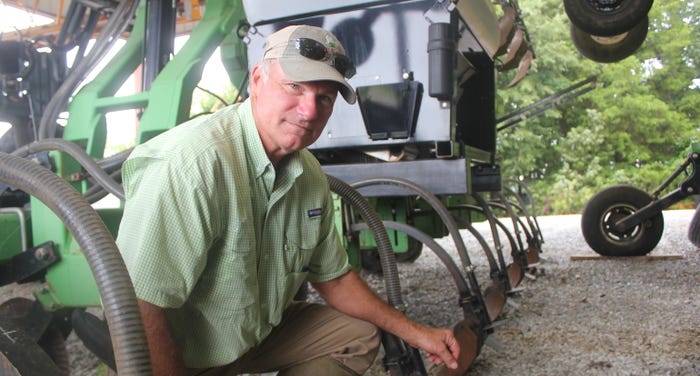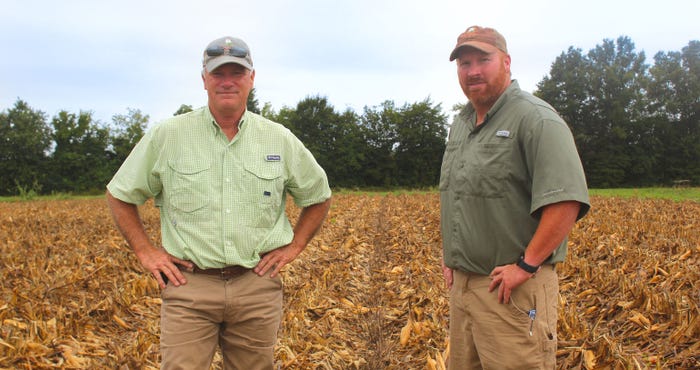
Joe Huerkamp and son Tyler (not pictured) mounted air seeders on their row hippers to plant cover crops. “It’s a really simple system,” Joe Huerkamp said. “We seed right behind the middle busters and just on top of the ground. As the dirt falls in, it covers it just enough.” Ginger Rowsey
The rigs parked in the Huerkamp farm shop are not something you see every day.
Two 12-row bedders — both mounted with air seeders. Hoses run from the seeder to an opener just above the middle busters. Father-son team Joe and Tyler Huerkamp call them a simple solution to the challenges of planting behind cover crops. Simple solutions are often the best.
“We were just trying to get away from cover on top of the row because of the issues we were having with planting,” said Joe Huerkamp, a cotton and corn grower in Macon, Miss. “We mounted air seeders on our hippers. Now we seed right behind the middle busters and just on top of the ground. As the dirt falls in, it covers it just enough.”
Most farmers who are using cover crops know the decision of when to terminate is a trade-off. Terminate too early and you don’t capitalize on the full benefits of weed control and erosion prevention that covers provide. Terminate later and you run the risk of excess biomass that slows planting and potentially decreases seed to soil contact.
Planting cover crops only in the row middles provides the best of both, according to the Huerkamps.
“By planting the cover just in the middles, we avoid the top of the row, so we don’t have the challenges with the planter. We also get better seed to soil contact if the cover is not on top of the bed,” added Tyler.
The Huerkamps are not necessarily planting green — Tyler says they like to terminate one week prior to planting corn and three weeks before cotton.
“But we could plant green if we had to because the cover crop is only in the row bottoms,” he said.
“It just seems to work better,” Joe added.
New approach to cover crops
The Huerkamps are primarily cotton farmers who rotate with corn. They got into cover crops several years ago through a USDA NRCS incentive program. They quickly saw benefits, including reduced soil erosion, less weeds and improved organic matter. As Joe said, “Every once in a while, the government will have a program that does what it needs to do.”
They now plant cover crops on 100% of their acres.
But there was bad with the good. The roots of some species, particularly cereal rye, can grow into underground tile drainage pipes and cause clogging issues. Then there was the excess biomass that clogged planters and generally made planting a headache.
The Huerkamps weren’t the only ones facing challenges planting behind covers. Their farming neighbors in Noxubee County were also experiencing difficulties with too much vegetation.
Joe credits his neighbors, the Skinners, with developing the concept of planting covers only in the middles behind the hipper. A great example of farmer ingenuity and creativity.
Last year Joe and Tyler tried it for themselves. They welded air seeders to their bedders, stretching hoses from the seeder to the middle busters. The air seeder blows the seed behind the busters. With just two days work, the Huerkamps had created an implement that would plant cover crops as it made row beds.
“This approach eliminates a trip across the field,” Joe said. “Before, we were broadcasting our covers solid, and it was just hard to get across the acres.” Eliminating a trip could prove to be a significant benefit this year as a late crop will leave less time for field work and planting covers. They Huerkamps say they like to finish planting cover crops by early December.
Other farmers in Noxubee County are now using this covers in the middles approach and the concept is beginning to catch on in eastern Mississippi.
“I talked with a farmer recently who said he wanted to come out and look at the rig,” Joe said. “As farmers we try to help each other out. We’ve learned a lot from other farmers, and when you find something that looks good and works you want to share it.”
This was the second year the Huerkamps have used the hipper/air seeder to plant covers. They have been happy with the results, especially erosion control. The cover’s ability to keep soil in place was certainly tested in 2021 when a June storm dumped nearly 16 inches of rain on their fields in a little over 24 hours. Improved water infiltration after years of planting cover crops combined with a good mat left between rows helped preserve the fields.

Looking ahead
2021 has been a test in many ways. An unusually wet and cool spring delayed progress. When we visited the Huerkamps in August, they estimated they were a month behind.
“One of the benefits of this method is that the soil doesn’t seem to dry out as fast if you only have cover in the bottom of the row,” Joe said. “In a typical year, that would be a good thing, but this year it worked against us a little because we had so much rain.”
But overall, the Huerkamps were optimistic about harvest. The field of dryland corn they had just shelled averaged 212 bu/a. The cotton crop was looking promising, too.
They will begin field work and cover planting soon after harvest. Before starting they plan to make a few modifications to their rig.
“We’re going to put an elbow on the seed opener on the buster to blow the seed back farther. We were getting too much dirt falling on it, and I think the seed was going a little too deep,” Joe said.
“We also plan to mount a camera on the back so we can watch it in the tractor. We want to look at the meter rollers. If they plug you can catch that quickly. The cameras are an inexpensive way to monitor that,” said Joe.
“It did what we wanted it to do last year, but we saw places we could make small improvements,” Tyler added.
Another change planned for next season is moving to a strictly black oats cover on most acres, although the Huerkamps will have some clover on about 400 acres.
“Cereal rye can get away from you, and when it gets too tall it’s hard to kill,” Joe said. “We like black oats because it produces good biomass but is much easier to terminate.”
“We’re still experimenting with cover crops and learning more each year.”
And they will keep looking for those simple solutions that make their farm more efficient.
About the Author(s)
You May Also Like






